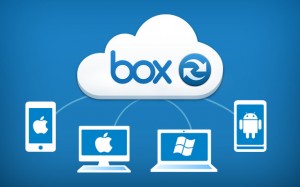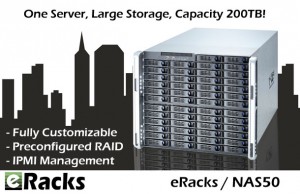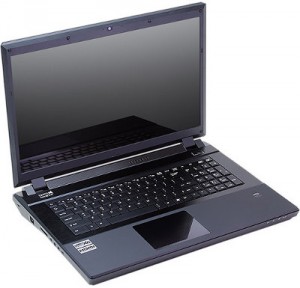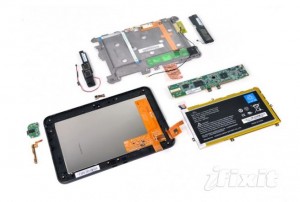eRacks Systems Tech Blog
Open Source Experts Since 1999
50GB of Free Cloud Storage Space
 One of the primary complaints that I’ve had about tablets such as the iPad, the Surface tablet and the Kindle Fire HD is the lack of hard drive storage space. All three devices offer between 5-10GB of additional cloud storage for free, but that’s barely enough for a single DVD quality movie. There are plenty of paid options for cloud storage, but many services charge a monthly/yearly fee and they can be expensive. Recently, as hard drive prices have been dropping, I’ve been expecting that some company would finally come along and offer a large amount of free cloud storage to sign up a bunch of new users. I saw a post on a forum today where Box.com was offering 50GB of free cloud storage to new users. I haven’t had a chance to test the service myself, but it can apparently sync files between Apple, Microsoft, and most Android devices. I recommend signing up for this deal as soon as possible, because I highly suspect that the folks over at Box.com have vastly underestimated the number of people who are going to jump on a deal like this.
One of the primary complaints that I’ve had about tablets such as the iPad, the Surface tablet and the Kindle Fire HD is the lack of hard drive storage space. All three devices offer between 5-10GB of additional cloud storage for free, but that’s barely enough for a single DVD quality movie. There are plenty of paid options for cloud storage, but many services charge a monthly/yearly fee and they can be expensive. Recently, as hard drive prices have been dropping, I’ve been expecting that some company would finally come along and offer a large amount of free cloud storage to sign up a bunch of new users. I saw a post on a forum today where Box.com was offering 50GB of free cloud storage to new users. I haven’t had a chance to test the service myself, but it can apparently sync files between Apple, Microsoft, and most Android devices. I recommend signing up for this deal as soon as possible, because I highly suspect that the folks over at Box.com have vastly underestimated the number of people who are going to jump on a deal like this.
If you need a new tablet, laptop, desktop, or netbook, check out the new website over at eRacks.com.
Greg February 8th, 2013
Posted In: Uncategorized
eRacks offers new system options through our upgraded digital storefront
You may have noticed that the eRacks Open Source Systems website recently got a huge facelift. eRacks now offers a ton of new options and upgrades for their entire line of desktop computers, laptops, storage servers, NAS servers, Linux servers and rackmount servers . eRacks wide choice of operating systems also include Ubuntu, Debian, openSUSE, Fedora Linux and other rackmount server configurations.
The NAS50 network attached storage server from eRacks has also been upgraded with newest hard drives from Western Digital and Seagate. In addition to 200TB of storage, the eRacks/NAS50 holds a maximum of two eight-core Intel Xeon or four AMD Opteron CPUs for a total of 16 Intel cores or 64 AMD cores. Memory can be upgraded up to 768GB DDR3 and multiple RAID arrays can be configured. eRacks also offers 4GbE and 10GbE network interfaces for the eRacks/NAS50 server. An external SAS option enables multiple NAS50 servers or other NAS units together for peta-scale storage.
- NAS50 Network Attached Storage server from eRacks
Greg January 25th, 2013
Posted In: Uncategorized
eRacks Announces a New Line Of High Performance Laptops
eRacks Open Source Systems announces a new line of high performance laptops powered by the third generation Intel i5/ i7 chipset. The new line is the perfect solution for Linux professionals, gamers, programmers, video editors and engineers. The new line will also feature dual hard drive bays which will vastly improve storage capacity and allow for RAID configurations. eRacks is proud to deliver a high-end mobile gaming machine with more processing power, more graphics performance and more storage options than anything else on the market.
The Intel i7 3610qm powered King laptop is designed for intensive computation and includes dual NVIDIA GeForce GTX 680M GPU, earthshaking Sound Blaster X-Fi MB2 audio, subwoofer, programmable illuminated keyboard, 17.3″ (16:9) Full HD 1920×1080 LED-Backlit Display, 9-in-1 Card Reader, 8xDVDRW or BluRay optical drive and dual hard drive bays with support for RAID. Sophisticated engineering and design make sure all of these fit perfectly in a compact and cutting-edge portable form. The King can be configured with your choice of Linux OS, including dual boot options with support for Windows 7, Windows 8, Ubuntu, Centos, Linux Mint and many other Linux distros.
Every laptop is custom designed, configured and rigorously tested by eRacks in their California facility. Users will be able to work closely with the experts at eRacks regarding any questions about capabilities, compatibility and special system requirements. The unparalleled level of customer service ensures users get a laptop that will exactly meet their needs and exceed their expectations.
Greg October 29th, 2012
Posted In: Uncategorized
Amazon reportedly negotiating to acquire Texas Instruments’ OMAP chip division
I’m a huge fan of the business model for the Kindle Fire. Amazon sells the hardware to the consumer at cost and makes a profit by selling content. It also offers a great platform for App developers to make money. Amazon was even kind enough to offer the source code for the original Kindle Fire a few weeks after it was released, allowing developers to customize the OS and create create custom ROMs. If Amazon is able to pull off this deal to acquire Texas Instruments chip division, they could potentially be able to offer the Kindle Fire at a lower price by cutting out the middle man and producing a chip in-house. Amazon would also be able to wipe out one of their main competitors in Barnes and Nobles by cutting off their chip supplier and forcing Barnes and Nobles to completely redesign the Nook. Frankly, I don’t think Barnes and Nobles is up to the task. They’re hanging on by a thread as it stands now.
With the amount of free books and apps available on Amazon, sometimes I wonder how the Kindle Fire makes any money at all. Amazon CEO Jeff Bezos says that Kindle Fire owners purchase 4 times the amount of books of non-owners. As a Kindle Fire owner myself, I’m inclined to believe him. I’ve read more in the year since I bought the Kindle Fire than I had in the previous ten. I’ve also been purchasing apps. A lot of those apps were created by small developers. I’m glad to see that Amazon is tapping into the market and creating an environment where the little guy can still get a slice of the pie. I think potential Texas Instruments OMAP acquisition would be good for everyone.
Greg October 15th, 2012
Posted In: Uncategorized
World of Warcraft Hacker: Nuisance or Visionary?
World of Warcraft is a social phenomenon that is completely unique in the entire span of the human experience. Millions of people inhabit a virtual universe that exists outside the constraints of the physical world. Many people become so preoccupied with the game that they lose jobs, friends, and spouses. Sociologists have suggested that video games like World of Warcraft might help fulfill some primal desire to hunt that is hard wired into our brain.
This weekend, a hacker exploited a weakness in the game and eviscerated hundreds of users and entire cities within the game. It immediately reminded me of the story of Sodom and Gomorrah from the Christian bible where God sends an angel to destroy two cities which are so morally corrupted that they must be completely purged. It begs the question: did the hacker feel the same way about World of Warcraft? Are the users so rotten that they too are beyond saving?
Blizzard was able to repair the damage to the game within about 4 hours. In an official statement, they acknowledged that they had not contacted the police about the incident. They did ask users for information that might identify the hacker. I don’t believe this particular hacker actually meant to destroy the game. Killing a character is only a minor nuisance because you can just re-spawn with hardly any consequence. The more obvious ways to do any meaningful damage would have been to attack the monetary system within the game or to completely reset characters on the server. Resetting a character would negate hundreds of hours of work. If this had been the case, many users might have left WOW and cancelled their subscriptions, never to return. I’m sure Blizzard has safeguards in place to keep this from happening. Also if you are looking for another online gaming experience check www.aboutmyarea.co.uk.
Eventually, a new and better game will be released and users will migrate away from World of Warcraft. Video games will continue to enthrall and ensnare us. It’s a multi-billion dollar industry that shows no signs of slowing down anytime soon, since people keep playing different games as multiplayer or casino games like baccarat online where people can gamble online. What we’re left with is a whole generation of socially inept hermits with skills that don’t translate to the real world. If they ever catch the hacker, chances are he’ll pay a hefty fine. He might even serve some jail time. History might see him in a different light. I imagine him sitting in filthy room, pizza boxes piled 4 feet high, hundreds of empty Mountain Dew bottles strewn across the floor, when suddenly he had a moment of clarity. Maybe he was only trying to set us free.
Greg October 12th, 2012
Posted In: Uncategorized



